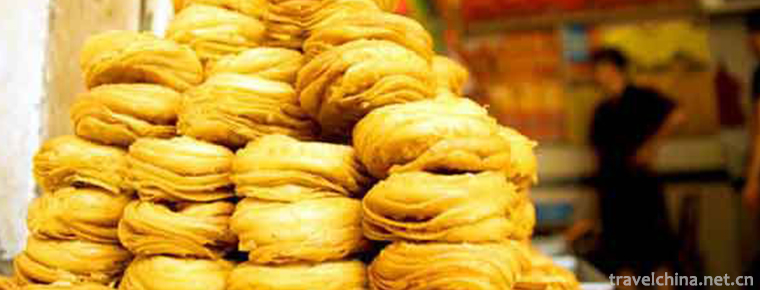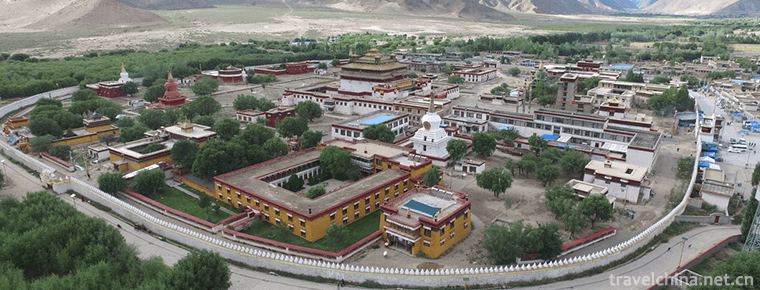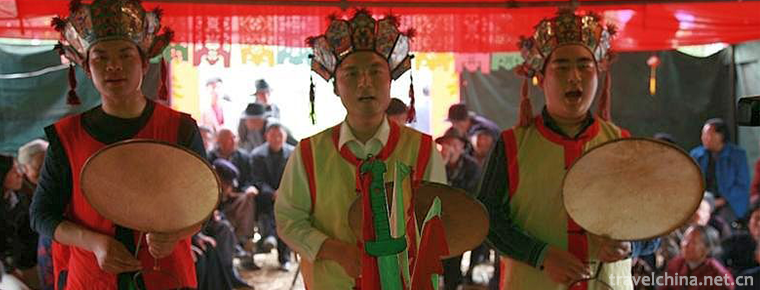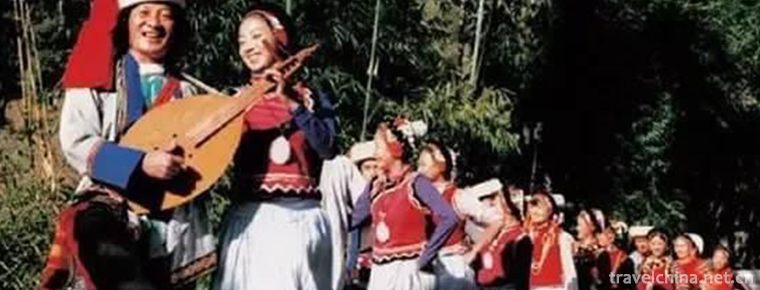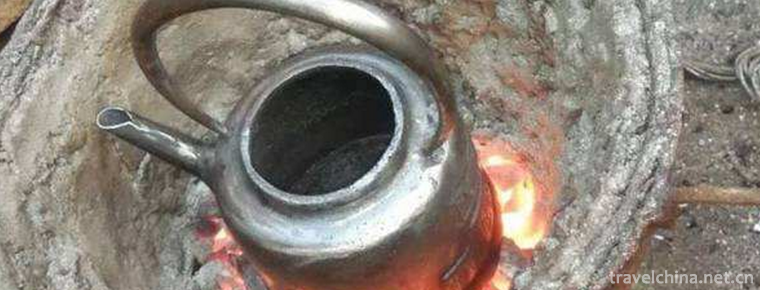Korean Agricultural Music and Dance
Korean Agricultural Music and Dance
"Agricultural Music and Dance" is commonly known as "Agricultural Music", which is spread in the Korean community of Jilin Province, Heilongjiang Province, Liaoning Province and other places. History can be traced back to the sacrificial ceremony of "stepping on the earth god" in the ancient Korean era when spring sowing and autumn harvest. Agricultural music and dance are divided into twelve parts. Korean farming music (like Hat Dance and begging grain dance) is the first national intangible cultural heritage.
On September 30, 2009, the fourth meeting of the UNESCO Intergovernmental Committee for the Protection of Intangible Cultural Heritage, held in Abu Dhabi, United Arab Emirates, considered and approved the inclusion of Chinese Korean folk music and dance in the List of Representative Works of Human Intangible Cultural Heritage.
On May 20, 2006, Korean folk music and dance was approved by the State Council and listed in the first batch of national intangible cultural heritage list.
historical origin
Korean Agricultural Music and Dance, Elephant Hat Dance
Declaration area or unit: Yanbian Korean Autonomous Prefecture of Jilin Province, as a traditional form of entertainment, elephant hat dance has a long history. Legend has it that it evolved from the disturbance of the ancient Korean people who tied elephant hairs to the tips of their caps and swayed them from side to side to drive away wild animals while cultivating. It was also said that it originated from a form of expression of celebration when the ancient Korean people shook their hair after hunting wild animals and other food. Anyway, the elephant hat dance has developed into a comprehensive folk art, which integrates music, dance and singing with considerable skills and rich connotations. According to historical records, every October after the autumn harvest, ancient Korea held a solemn ceremony of "sacrifice to heaven", people "eat and dance all night", thank God for the gift, celebrate the harvest. Therefore, this kind of dance is also called "Agricultural Music and Dance", and the elephant hat dance is the highest form of expression, showing the highest skills and the most exciting point in the whole "Agricultural Music and Dance".
Korean Agricultural Music and Dance Beige Dance __________
Declaration area or unit: Benxi City, Liaoning Province
Benxi Korean Agricultural Music and Dance (Beggie Dance) is inherited from Hengdaochuan and Liudaohe areas of Huanren Manchu Autonomous County in eastern Benxi City, Liaoning Province. The unique geographical environment of Qili Dance, which is characterized by rolling hills, dense forests, traffic congestion, and unique geographical environment, constitutes a special environment for Qili Dance's unique folk culture ecology and inheritance. As the origin of Korean folk dance, there is evidence to prove that the earliest record of Benxi and its surrounding areas can be traced back to the Han Dynasty. In the tombs of Huanren and the surrounding aristocratic officials, a variety of murals around the 5th century were unearthed, which vividly depicted the dance situation at that time. Double-deck dance has a long history. Its emergence is closely related to the tug-of-war activities favored by the Korean people. The day of tug-of-war is scheduled for the fifteenth day of the first lunar month each year. It takes about ten days from preparation to the end. The tug-of-war activities are generally divided into three stages: fund-raising stage, rope-making stage and competition stage. At the stage of the competition, because there are too many participants and spectators, "cheerleading" songs and dances, it is difficult to play a role for a while. So, let seven or eight-year-old children stand on the shoulders of adults, singing and dancing. After the tug-of-war, the winner carries the prize, Giant Cable, and lets the children standing on their shoulders sing and dance all night. Later, people gave this form of performance an image name, which is what we call "double-decker dance" today. "Begging grain" is the activity of begging for grain. Before the currency came into being, the Korean people exchanged goods with rice instead of money. There are two main forms of begging grain dance: one is to organize people who can sing and dance, wear bright national costumes, play drums and perform in front of rich families, businesses and stores, and invite them to come out for financial support whenever a major event or a large-scale event is to be held in a Korean-inhabited area; the other is to organize people who can sing and dancing well. In order to build and renovate the temple, the monks in the temple took cymbals in their hands and read scriptures while knocking, and went to every household for cultural purposes. Until now, the commander of begging grain dancing is also dancing with cymbals in his hands.
Beggar grain dance is a kind of farm music and dance, which originates from the folk activities of praying for the harvest of agriculture. Beggar grain dance has a relatively stable traditional formula. The performers dance according to the emotions on the spot, and the whole dance has improvisation. Men shake their elephant caps to make the top reel fly; girls beat long drums while spinning fast; the old actors'movements vary greatly. Begging grain dance, with many participants, is a typical representative of Korean peasant group dance.
Begging grain dance is mainly performed in major festivals or large-scale activities of the Korean people, such as Zuozhou (one-year-old birthday), Huijia (sixtieth birthday), remarriage (sixtieth anniversary of marriage) or wedding, shop opening, construction and repair of temples, the elderly in the village will organize singing and dancing performances. Beggar grain dance is mostly inherited through the family.
Style and characteristics
Korean Agricultural Music and Dance, Elephant Hat Dance
Declaration area or unit: When performing farm music and dance in Yanbian Korean Autonomous Prefecture, Jilin Province, each village sends its own huge dance team to participate in local celebrations. The front of the dance team was led by a flag and a flag with the words "agriculture is the foundation of the world", followed by a man who beat a gong at the head of the team as the commander-in-chief. Under his leadership, bands and disguised figures with Taiping Xiao, trumpets and various drums form part of the honor guard of the dance team. Next comes the troop of performers who perform small drums, flat drums, long drums, fan dances, crane dances, elephant hat dances, mask dances and pantomimes, with an unlimited number of participants. Elephant hat dance is an important form of farm music and dance. It has various kinds and techniques. It can be divided into "elephant hat", "medium elephant hat", "short elephant hat", "line elephant hat", "feather elephant hat", "tail elephant hat" and "spark elephant hat". Its techniques of tail flick include left-right flick, front-back elephant tail, single flick, double or even three flicks, standing flick, squatting, kneeling flick, throwing on the ground and so on. The elephant tail is several feet long and also several feet long. The elephant-throwing cap is the basic movement of elephant-hat dance, and also its unique performance skills. During the performance, the dancer frequently shakes his head with the power of his neck, shakes his head like a cap, and renovates the pattern of movement, including "flat shake", "left and right shake" and "main shake" and "dew drop". He can jump while shaking, perform such difficult movements as "elephant shake stride" and "lean down shake" and drive the drifting bands on his cap to form a smooth dynamic circle, bringing one to the audience. Cultivate a pleasant aesthetic feeling. The elephant cap dance is a group performance. It is very exquisite in performing, with certain steps and procedures. Firstly, the music sounds. First, the short elephant cap is thrown, accompanied by the drum, and the simple dance moves are done. Then, the middle elephant cap is changed, accompanied by the long drum, and the body movements such as drilling circle, spinning, turning on the ground are done. Finally, the long elephant cap is thrown by one or three people, and the difficult movements such as paper jumping, step climbing and circle people are done to make the dance reach its climax. In the process of dancing, they are accompanied by hand drums, long drums, side drums, gongs, Xiaojin, Dongxiao, Piccolo and Korean Suona. Elephant hat dance is lively and elegant, and its rhythm is cheerful and comfortable. It fully reflects the spiritual outlook and national temperament of the Korean people in their work. It is a precious wealth created by the Korean people in their long-term life.
Manufacturing process
The special craftsmanship of the elephant hat determines the performance of the elephant hat dance. The earliest elephant cap was made of a half-sawn gourd. A stick was inserted at the bottom of the cap. Then a long window paper was tied with a kraft rope and fixed to the stick. Dancers wear a variety of hats, mostly made of hard plastic, and their ribbons have evolved into a kind of "cellophane", which can be divided into elephant cap, medium elephant cap, elephant cap, elephant cap, feather cap, spark elephant cap and so on. Long, medium and short elephant caps are named for their different lengths of ribbons. The short ones are only more than 1 metre long and the elder ones are 12 metres long. At present, the longest ones are 28 metres. Others are named for the different material and decoration of ribbons and hats, such as the elephant feather cap, which is tied up with 10 egret feathers and tied on the top of the elephant cap to form a flickering belt, while the spark elephant cap is tied with dozens of fireflies on the long ribbon, and the performance is as if fireflies were flying up and down, which is extremely brilliant and dazzling.
Korean Agricultural Music and Dance Beige Dance Declaration area or unit: Beggar grain dance in Benxi City, Liaoning Province is a self-entertaining folk dance. It not only absorbs the essence of "double dance" in tug of war, but also melts the song and dance parts in the "begging" activities to form a unique form of performance. Beggar grain dance has a relatively stable traditional formula, but it is not entirely restricted by the traditional formula. Performers can dance according to the emotions of the scene, the whole dance has a strong improvisation. When the performers are in high spirits, everyone shows their magic power. Men shake their elephant caps to make the top of the long reel fly and draw beautiful arcs. Girls beat long drums while spinning quickly to convey their feelings with body movement and beauty. Older performers not only pay attention to the charm of dance, but also pay attention to gestures and movements. They can express their hearts'joy vividly through impromptu performances. All in all. Beggar grain dance is a typical representative of Korean peasant group dance because of its large number of participants and wide influence. When the festival is festive, the number of people participating in the performance is large and the scene is grand, which requires someone to come out to preside over and guide the dance team into the performance venue. From the entrance of the dance team to the change of various formation, until the dance is full of joy, the performance program is relatively stable. In the Korean activities such as "Weekly Doing", "Huijia Festival" and "Hui Marriage Festival", there is no need to enter and walk in formation because of the limitations of performance venues and participants. Therefore, the performance program has changed relatively. According to local conditions and changing circumstances, the main characteristics of the performance form of Beggar Granule Dance have been formed. The performance of Qili Dance (taking festival performances as an example) needs to be performed in a spacious venue, which can be attended by both men and women, old and young. Every performance, a few dozen people, more than several hundred people, but long drummer, round drummer is indispensable. The scene was warm and the lineup was strong. At the entrance, in front of the dance team were young men and old people wearing "xiang hats", who kept shaking the colorful silk on their hats. Next came the commander-in-chief of the whole dance team, an old man of high esteem in the village of Reed. With cymbals in his hand, he beat the rhythm as he walked, leading the dance team to the stage. The order is two drummers, two long drummers and young men and women in the dance team and the elderly. At the end of the dance team was the actor who performed the double-decker dance. On their shoulders stood a child, who was dancing with colored silk (or flowers) in his hand. In the "double-deck dance", there should also be an old man over the age of flower armor, who should occupy a prominent position in the elderly. After the dance team appeared, it gradually formed a big circle, drummers, long drummers, young men and women and the elderly, and then came down to the scene to perform their best skills. After the climax, the performers will return to their positions in the cymbal sound of the commander-in-chief and withdraw in line. Begging grain dance is mainly performed in major festivals or large-scale activities of the Korean people, such as Week (first birthday), Huijia (sixtieth birthday), remarriage (sixtieth anniversary of marriage) or wedding, shop opening, construction and repair of temples, the village elderly will take the lead in organizing singing and dancing performances. Beggar grain dance is mostly inherited through the family.
custom
Korean people are good at singing and dancing. Whether it is a festival or a family gathering, men, women, old and young are accustomed to dancing with steady drums and karaoke piano. The Korean people living under Changbai Mountain in northeastern China have been engaged in rice production in the north for a long time. In order to facilitate large-scale rice planting and management, they mostly take the form of collective labor and mutual cooperation. Every time people go to the ground, they take "flat drum" and "suona" with farm implements to the fields. When resting, people will rise to dance in the lively drum music to wash away fatigue with happy singing and dancing. With the passage of time, these impromptu songs and dances gradually formed amusement Korean folk dances, which run through various traditional folk activities.
Cultural characteristics
Founded in agricultural labor and with ancient sacrificial ingredients, the Korean representative folk traditional activity "Agricultural Music and Dance" generally has two forms, one is to perform in the form of dance and mime, and the other is to perform in the mass at the beginning of the New Year and during the festive harvest season, with warm and rich traditional dance as its content. At that time, each village will send its own vast "Agricultural Music and Dance" dance team to participate in local celebrations. At the front of the dance team, the leader was "Lingqi" and "Agricultural Flag" with "Agriculture is the foundation of the world", followed by a man who beat "Xiaogong" as the commander-in-chief at the head of the dance team. Under his leadership, bands with "Taiping Xiao", "trumpet", "various drum instruments" and various disguised figures formed the honor guard part of the "Agricultural Music and Dance" dance team. Next is the troop of performers who will perform "small drum", "flat drum", "long drum", "fan dance", "crane dance", "elephant hat dance", "mask dance" and "mime". The performance of "Agricultural Music and Dance" consists of twelve parts. There are "small drum dance" performed by young men, "double arhat dance" performed by dancing children, traditional "flat drum dance" performed by many people, long drum dance performed by both men and women, fan dance originated from ancient "witch dance", "crane dance" performed by many people with large flower fans, and "elephant hat dance" performed by men who finally pressed into battle. Firstly, under the beating of different rhythms of "Xiaogong", the "Xiaogu" performed by young men appeared as the stylized opening program of "Agricultural Music and Dance", followed by a group of dancers who performed various forms, formation changes and "overlapping Luohan" performances with rapid rotation accompanied by "Yanfeng Typhoon" music. With the progress of the program, the artistry of the dance performance becomes more and more strong. The traditional "flat drum" performed by many people is a kind of "encouragement" that both men and women can participate in. The size of the flat drum used by each person varies according to gender. Men's performances are mainly group dances. Dancers run and jump in the fierce and jubilant drums, fully demonstrating the masculinity of men. The female solo dance of "flat drum" should not only show various and skilled drum beating skills, but also dance the Korean women's strong and soft, graceful and vigorous dance posture under the sound of "flat drum" with frequent pauses, frustrations and rhythms. These two types of flat drum with style always attract people's applause.
Nowadays, although the Korean "Long Drum Dance" has been well known, many people mistake it as a Korean women's dance. In fact, the folk "long inspiration" is a dance that can be performed by both men and women. "Long Drum" is one of the most beautiful and unique instruments of the Chao nationality. It has a long stature, slender waist, different timbre of drum skin at both ends, and beats with drumsticks, whips and fingers. It has rich expressive force and characteristics. "Long Drum" is not only an instrument, but also a favorite dance instrument. Accompanied by the melodious karaoke instrument, they hold a 30 cm long bamboo "drum whip" in their right hand, and with the cooperation of the left finger palm, beat out crisp, harmonious and different sounds of drums from the left and right drums. In the music, a group of dancers wearing white short clothes, light red dragging skirts and "long drums" tied to their bosoms, stepped on the gentle dancing steps of the Songsong Spring and flowed around the stage. Their graceful dancing posture with loose shoulders and lifting arms is as soft as wax flame and as light as weeping willows. It is intoxicating and fascinating to dance leisurely like a flying white crane. After a slow version, the dancer pulls out another wooden drumstick and strikes a strong and fast rhythm. The dance is vigorous and bold as the drum music enters the wild rush. At this time, the performers who indulge in climax begin to show their unique skills of "inspiration" and push the performance atmosphere to the climax. After the "Long Drum Encouragement", many people held large flower fans and began to perform the "Fan Dance" originating from the ancient "witch dance". Dancers perform in single or double fans with decorative patterns and shapes. Next comes the dance of the pseudomorph. Dressed as a group of red-crowned cranes with beautiful long-necked crane heads and two black wings, they take lightweight and elegant strides and jump the "crane dance" to fly, praying for the future auspiciousness and tranquility. The "Hat Dance" for the men who finally pressed the battle for the "Agricultural Music and Dance" is always a remarkable and exciting dance. One by one, wearing festival costumes and discs with ribbon caps, the young men performed in standing, walking and branching, turning to the ground posture, using their heads to throw the ribbon out of the horizontal, vertical and inclined arcs. More skilled people are in the center of the venue, performing the difficult skills of shaking up to 20 meters ribbon. Suddenly, a number of ribbons full of eyes, like thousands of neon came out across the sky, if thousands of silk rain whirls into the blue sky, people can not catch sight of, imagination. In the climax, dancers holding "small drums", wearing "flat drums" and "long drums" came on the stage again, dancing again in the flurry of ribbons, as the end of "farm music and dance". After the rich and enthusiastic "Agricultural Music and Dance", people will turn to self-entertainment collective self-entertainment dance as a continuation of festivals.
Inheritance status
Korean Agricultural Music and Dance, Elephant Hat Dance
Declaration area or unit: Yanbian Korean Autonomous Prefecture, Jilin Province
Elephant hat dance is widely spread in Wangqing County, Jilin Province. During festivals, weddings, leisure farming and competitive activities, men, women, old and young gather together and perform heartily. As elephant hat dance is one of the unique Korean representative dance forms, and has a high degree of skill, it is loved by people. According to the survey, as early as 1949, Wangqing County set up an elephant hat dance performance team. Liang Tairong, the first generation of elephant hat dance, taught elephant Hat Dance skills. At festivals, weddings, agricultural leisure and competitive activities, men, women and children gathered together to perform heartily. Agricultural music and dance, as a representative mass culture and art of the Korean people in 1954, came to the stage in the form of elephant hat dance through the hard work of many performers, and presented itself to the world with a brand-new look. Elephant Hat Dance is one of the most distinctive dances of Korean nationality, which has developed to the sixth generation. Its dance form has also developed from simple field entertainment to performance by professional literary and artistic groups, and has won national and provincial awards many times. Nevertheless, its development is facing a difficult situation. With the development of the times, the traditional culture has been impacted, and the inheritance and protection of the elephant Hat Dance are also facing great difficulties. On the one hand, the professional dancers with higher attainments are aging and aging, and the backbone talents are losing and cutting off. On the other hand, with the development of the times, the traditional culture has been impacted. Few people concentrate on practicing the elephant hat dance, and the professional talents are becoming fewer and fewer. In order to protect and inherit this precious national art, Wangqing County holds training classes for elephant hat dance every year to train reserve talents for elephant hat dance. At the same time, it extensively develops elephant hat dance performance activities to promote and popularize elephant hat dance.
Korean Agricultural Music and Dance Beige Dance Declaration area or unit: Benxi City, Liaoning Province
It integrates many forms of dance, such as Xiangmao dance, long drum dance, disc dance, double-deck dance, and so on. It shows the high inheritance of folk music and dance. The dance was included in "The Integration of Chinese National Folk Dances". As a national key art scientific research project during the "Seventh Five-Year Plan", Qili Dance, an ancient art form, has entered contemporary reality and is increasingly accepted by generations of artistic researchers and successors through the efforts of several generations of artistic researchers and successors. The popularity of the Korean people has attracted the attention of the provinces and the state. In 1989, the dance won the first prize of the Second Culture and Art Festival of China (the first culture festival of Liaoning Province); in 1991, it won the Excellent Performance Award of Shenyang (the first) International Yangko Festival of China; in October 1994, it represented Jinjing of Liaoning Province in the celebration of the 45th Anniversary of the founding of the People's Republic of China; in 2005, it won the gold prize of Liaoning National Folk Dance Competition; and in 2006, it was List of publicity of representative works.
However, due to the impact of modern civilization and the death of artists, this ancient art is facing the danger of losing its heritage and needs urgent rescue and protection.
Inheritance significance
Beggar grain dance with rich content and distinctive features has a long history, and is a brilliant pulse in the multiculturalism of the Chinese nation. Compared with the "stepping on the earth god" dance and the self-entertainment dance, the most prominent feature is its distinctive performance, which is a form of farm music and dance for people to watch. Its dance form is complex, the movement washes and practices, the skill is superb, therefore enjoys the unique status in the Korean nationality dance. As a member of the great Chinese dance family, it embodies the unique artistic style of Korean folk dance and has high historical and cultural value. It enriches Chinese folk culture and art with its unique regionality and extensive popularity, and is a unique artistic branch of Korean dance, farmer music and dance. However, due to the impact of modern civilization and the death of artists, this ancient art is facing the danger of losing its heritage and must be rescued and protected.

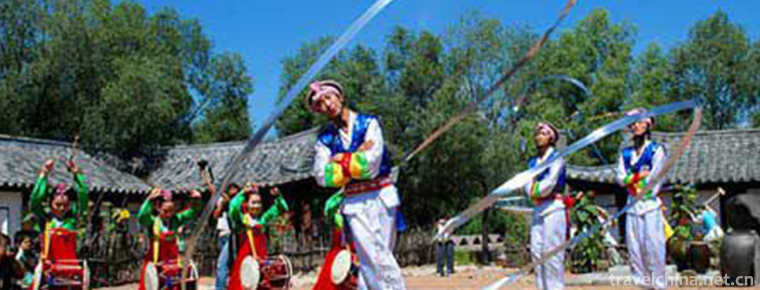
-
Anhui rescue
Anhui rescue Great rescue is a traditional feature of Shouxian County in Anhui Province, which has a history of more than 1000 years..
Views: 210 Time 2018-11-27 -
angye Temple
Sangye Temple, also known as Cunxiang Temple and Wubian Temple, is located in Sangye Town, Zaburg County, Shannan District, Tibet Autonomous Region, under the Habu Mountains on the North Bank of the Y.
Views: 173 Time 2019-02-07 -
Production Techniques of Buyi Medical Herbs for Benefiting Liver
Guiding County, Guizhou Province, is a subtropical monsoon rheumatic fever climate with distinct seasons, rich heat, long frost-free period, abundant rainfall and complex and.
Views: 318 Time 2019-04-04 -
End drum cavity
Weishan Lake Drum Tune, also known as Duangong Tune, is a traditional folk art of the Han nationality originating in Weishan County and Dongping County of Shandong Province .
Views: 212 Time 2019-04-28 -
Jinling Classic Carving and Printing Techniques
Jinling classical engraving and printing technology, local traditional handicraft in Nanjing, Jiangsu Province, is one of the national intangible cultural heritage..
Views: 270 Time 2019-05-06 -
Maonan Fat Cover
"Fat set" is the general name of Maonan people's vow-making activities. It prevailed in the Ming and Qing Dynasties. At the beginning, Maonan people used Nuo rituals to sacrifice the heavens.
Views: 78 Time 2019-05-27 -
Nu Dabian Dance
"Dabian Dance" is one of the representative dances of the Nu nationality, which is spread in the Nujiang Lisu Autonomous Prefecture Fugong County Nu villages. Dabian dance is characterized b.
Views: 126 Time 2019-06-08 -
Smelting and Casting Techniques of Pig Iron in Yangcheng
Yangcheng pig iron casting technology was invented in the 6th century BC. Yangcheng pig iron smelting and casting technology in the smelting and casting process first crushed the ore, then roasted at .
Views: 104 Time 2019-07-10 -
Da Zang Temple
Located in the north of malkang County, dazang temple is about 500 kilometers away from Chengdu City and is located in the deep mountains above 3000 meters above sea level. .
Views: 243 Time 2020-11-07 -
Suining transportation
Suining is a transportation hub city in Sichuan Province, with an equal distance of 128 km between Suining and Chengdu Chongqing. It is an important node city and secondary comprehensive transportation hub between Chengdu and Chongqing. 237km "3-way 7-line" railway.
Views: 124 Time 2020-12-16 -
Yibin economy
In 2019, Yibin City will realize a GDP of 260.189 billion yuan, an increase of 8.8% over the previous year in terms of comparable prices. Among them, the added value of the primary industry was 27.764 billion yuan, an increase of 2.9%; the add.
Views: 282 Time 2020-12-18 -
Dazhou environmental protection
In 2019, the afforestation area of Dazhou city is 11666.60 hectares, the forest area is 735300 hectares, and the forest coverage rate is 44.34%. The air, water and soil pollution prevention and control were carried out in depth. The air compliance rate .
Views: 95 Time 2020-12-20
